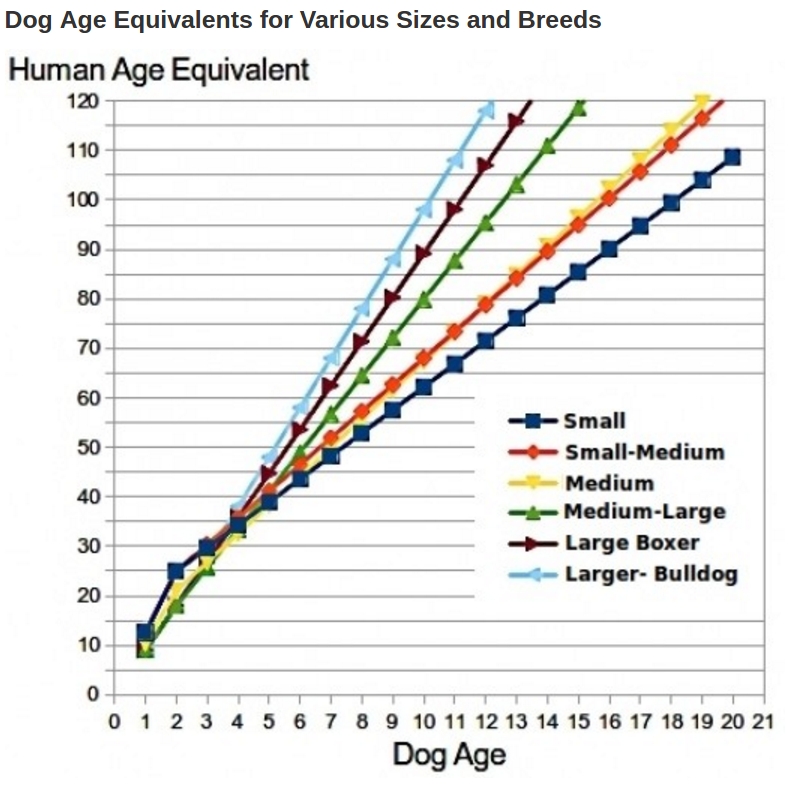Dog Age in Human Years - Chart for Dog Age and Years Conversion
The old rule of thumb that you can estimate the age of your dog in human terms, bymultiplying the dog's age by seven, has proven to be a good general guide, but is inaccurate in detail for various breeds and sizes.
Research has shown that the lifespan of dogs depends mostly on their weight, not their size or breed. Small dogs weighing less than 30 pounds (15 kg) live the longest with 40% of them exceeding 10 years. Dogs weighing more than 100 pounds (50 kg) seldom live beyond 6-7 years, and only about 10% of these largest dogs reach the age of 10 years.
It is common to hear of 17 year old miniature poodles, Chihuahuas and terriers. However, most Labrador retrievers, Beagles, Boxers and similar medium size dogs seldom exceed 12 years.
The oldest known human was 122 years, whereas the oldest known age for dogs is 30 years for Terrier, Labrador cross, Australian Cattle Dog. Incidentally, the ratio between these record maximum ages does not correspond with the 7 times rule (7 x 30 = 210).
So how long can you expect you dog to live?
Which breeds live then longest and shortest?
If you can't resist the 'doggie in the window' it may be wise to consider how long it is likely to be sharing its life with you.
See charts and graphs that allow you to convert dog age to human equivalents.
How Long Do Dogs Live?
Dogs are one of the most variable species of mammal on the planet, primarily because of the selective breeding programs that have been conducted over centuries.
Dogs can range in weight from 6 lb (3kg) to 200 lb (90kg) and they have widely different body shapes.
Two breeds of the same height when fully grown may vary widely in weights, for example a greyhound and a bulldog, a whippet and a pug.
The general relationship between between body size and lifespan in mammals is generally in the opposite direction.
Large species such as elephants, gorillas and whales live much longer than shrews, mice and voles.
For dog breeds within a common species the opposite is true. The reason for this is unclear.
For humans, being overweight and obese tends to lower life expectancy. But this is unrelated to the pattern in dogs.
The table below shows the expected lifespan and maximum known ages for dogs.
People who want to choose a long-lived dog should choose the smaller breeds.
However, the mixed breed and muts generally tend to live longer than pure-breeds of the same size.
Female dogs also tend to live longer.
Many pure breeds of dogs have a number of inherited health issues that can reduce their life spans. Mutts don't have any inbreeding and benefit from so-called hybrid vigor.
Cancer is very common in dogs and is a major reason why dogs don't live longer.
For older dogs, cancer is the most frequent cause of death, and about 40% of dogs die of some form of cancer.
Some breeds have very high rates of cancer, such as Boxers, Bernese mountain dogs, Golden retrievers and Rottweilers, have unusually high rates of cancer and this reduces their life expectancy.
Average Age for Dog Breeds and World Record Oldest Dogs
| Dog Breed | Average Life Expectancy |
|---|---|
| Beagles | 12 to 14 years |
| Boston terriers | about 15 years |
| Boxers | 11 to 14 years |
| Bulldogs | 10 to 12 years |
| Chihuahuas | 15 years or more |
| Dachshunds | 12 to 14 years |
| Doberman Pinschers | 10 to 12 years |
| German Shepherd | 10 to 14 years |
| German shorthaired pointers | 12 to 15 years |
| Golden retriever | 10 to 12 years |
| Labrador retriever | 10 to 14 years |
| Maltese | 15 years or more |
| Miniature Schnauzers | 15 years or more |
| Pomeranians | 13 to 15 years |
| Poodles | 10 to 15 years |
| Pugs | 12 to 15 years |
| Rottweilers | 10 to 12 years |
| Shetland Sheepdogs | 12 to 14 years |
| Shih Tzu | 11 to 15 years |
| Yorkshire terrier | 12 to 15 years |
| World Record Ages for Dogs | |
| Terrier | 30 years |
| Labrador cross | 30 years |
| Australian Cattle Dog | 30 years |
| Poodle | 29 years |
| Cross-breed | 28 years |
| Border Collie | 28 years |
| Labrador | 27 years |
| Beagle | 27 years |
| Shih Tzu | 27 years |
| Cross-breed | 27 years |
| Mutt | 23 years |
| Dachshund | 23 years |
| Dachshund-Terrier cross | 21 years |
Dog Age Equivalents to Human Life Span and Ages
Many dog owners like to image how old their dog is in human year equivalents. The usual way of doing this is to multiply the dogs are by seven. So a dog aged 1, 2, 5, and 10 years is estimated to be 7, 14, 35 and 70 years in human terms.
Recent research has provide a more accurate method for various breeds and sizes of dogs. It turns out that the first two years are different from the rest and are related to the weight and size of the dog:
- Small Dogs age 12.5 years in human equivalents for the first two years
- Medium Dogs age 10.5 years in human equivalents for the first two years
- Large Dogs age 9 years in human equivalents for the first two years
So after 2 years, small dogs are 'twenty-something', large dogs still in their teenage years and medium size dogs have learned to drive and can vote!
Smaller breeds have a very brief juvenile period, start breeding sooner, and have an extended and long drawn-out adulthood.
On the other hand, large dogs take two years or more to achieve their full mature skeletal body size. They then may only live for another 4-5 years.
Anyone who has owned a Labrador knows how long it takes for them to grow up an stop acting like kids and eating the socks and underwear.
Small dogs at two are very mature and have taken charge of their households.
The differences between species can be extreme with Bulldogs only living for an average of 6 years whereas a Border Terrier, and many other terriers live well past 14 years of age.
Oddly, smaller dogs are older in human terms than big dogs, but the situation reverses by the age of 5 years when the bigger dogs are older in human terms.
The rate at which dogs age in human equivalents varies with body size and weight. The annual increase in human equivalent years past the age of three years is shown in the table below for various types of dog. To summarize the average rate of increase has been averaged for various size groups. This is shown below,.
Examples of the breeds belonging to each species are shown in the table.
Bulldogs have a very short lifespan and they have been excluded in generating the averages.
- Small - 4.6 human years for each year after dog age of two
- Small-medium - 5.4 human years for each year after dog age of two
- Medium - 5.8 human years for each year after dog age of two
- Medium - Large - 7.7 human years for each year after dog age of two
- Large - 8.9 human years for each year after dog age of two
- Larger Bulldog-Like - 10 human years for each year after dog age of two
- Bulldog - 13.2 human years for each year after dog age of two
Doing the calculations provides the image and table below which summarize the relationship between dog ages and human equivalents for the various dog categories.
You can easily work out the human-age equivalent for your dog by using the chart and image.
The bizarre turn around where smaller dogs and older in human terms at 2-dog years of age is clearly shown in the graph.
The bigger dogs get 'older' faster in human terms, and are 'older' than the smaller dogs after the age of 5 years.
The 7-year multiplier only really works for younger dogs up to the age of 10 dog years.

Dog Age Equivalents in Human Years for Various Sizes and Breeds of Dogs
| Dog Age | Small | Small - Medium | Medium | Medium - Large | Large - Boxer | Larger - Bulldog | 7 year Rate |
|---|---|---|---|---|---|---|---|
| 1 | 13 | 13 | 11 | 9 | 9 | 9 | 7 |
| 2 | 25 | 25 | 21 | 18 | 18 | 18 | 14 |
| 3 | 30 | 30 | 27 | 26 | 27 | 28 | 21 |
| 4 | 34 | 36 | 33 | 34 | 36 | 38 | 28 |
| 5 | 39 | 41 | 38 | 41 | 45 | 48 | 35 |
| 6 | 44 | 47 | 44 | 49 | 54 | 58 | 42 |
| 7 | 48 | 52 | 50 | 57 | 63 | 68 | 49 |
| 8 | 53 | 57 | 56 | 64 | 71 | 78 | 56 |
| 9 | 58 | 63 | 62 | 72 | 80 | 88 | 63 |
| 10 | 62 | 68 | 67 | 80 | 89 | 98 | 70 |
| 11 | 67 | 73 | 73 | 88 | 98 | 108 | 77 |
| 12 | 72 | 79 | 79 | 95 | 107 | 118 | 84 |
| 13 | 76 | 84 | 85 | 103 | 116 | 128 | 91 |
| 14 | 81 | 90 | 91 | 111 | 125 | 138 | 98 |
| 15 | 86 | 95 | 96 | 119 | 134 | 105 | |
| 16 | 90 | 100 | 102 | 126 | 112 | ||
| 17 | 95 | 106 | 108 | 134 | 119 | ||
| 18 | 99 | 111 | 114 | 126 | |||
| 19 | 104 | 117 | 120 | 133 | |||
| 20 | 109 | 122 | 125 | ||||
| 21 | 113 | 127 | 131 | ||||
| 22 | 118 | 133 | 137 | ||||
| 23 | 123 | 138 | |||||
| 24 | 127 | ||||||
| 25 | 132 |
Update: Having a Dog May Increase Your Lifespan
The American Heart Association has stated recently, that owning a pet, especially a dog, appeared to be associated with a reduced risk of heart disease. However the correlation may be misleading as it may be that healthier people who exercise more are more likely to get a dog. The association says that there are plausible physiological reasons, psychological, sociological reasons to argue that owning a pet might actually have a role in reducing cardiovascular risk. You only have to look at what caused people to go outside when the Boston shutdown was lifted - mostly it was to walk dogs with the owners dragged along behind.
The new report reviewed a whole host of studies, and over all it was clear that people with pets were generally in better health than people without pets. Several studies indicated that dog owners has a reduced reaction to stress, with a lower heart rate, lower blood pressure and reduced release of adrenaline-like hormone when a pet is present compared with when a pet is not present.
Pet owners also reported that they undertook more of physical activity. They also had modestly lower levels of triglyceride and cholesterol.
However most of the studies only showed correlations and did not prove cause and effect. Statistics from the Centers for Disease Control and Prevention indicated that that pet owners are equally likely to be overweight and obese as those with no pets. However walking the dog regularly can be effective. One research study showed that 22% of people without pets were obese, compared with 17% of those who owned dogs and walked them regularly. Dog owners who owned dogs but did not walk them showed an obesity rate of 28%.
Parameters for Calculating Dog Ages in Human Terms for Various Types of Dogs
| Size | Breeds | Rate for First Two Years | Rate for 3 + Years | Average Rate for 3+ Years | Class for Age Rate |
|---|---|---|---|---|---|
| Small | Dachshund (Miniature) | 12.5 | 4.32 | 4.6 | Small |
| Small | Border Terrier | 12.5 | 4.47 | ||
| Small | Lhasa Apso | 12.5 | 4.49 | ||
| Small | Shih Tzu | 12.5 | 4.78 | ||
| Small | Chihuahua | 12.5 | 4.87 | ||
| Small | West Highland White Terrier | 12.5 | 4.96 | ||
| Small | Beagle | 10.5 | 5.2 | 5.4 | Small-medium |
| Small | Whippet Medium | 10.5 | 5.3 | ||
| Medium | Staffordshire Bull Terrier | 10.5 | 5.33 | ||
| Medium | Spaniel | 10.5 | 5.46 | ||
| Small | Miniature Schnauzer | 10.5 | 5.46 | ||
| Small | Spaniel (Cocker) | 10.5 | 5.55 | ||
| Medium | Retriever (Labrador) | 10.5 | 5.74 | 5.8 | Medium |
| Medium | Golden Retriever | 10.5 | 5.74 | ||
| Small | Cavalier King Charles | 10.5 | 5.77 | ||
| Small | Pug | 10.5 | 5.95 | ||
| Small | French Bulldog | 9 | 7.65 | 7.7 | Medium-Large |
| Large | German Shepherd | 9 | 7.84 | ||
| Large | Boxer | 9 | 8.9 | 8.9 | Large |
| Medium | Bulldog (adjusted) | 9 | 10 | 10 | Larger-Bulldog |
| Medium | Bulldog | 9 | 13.42 |



